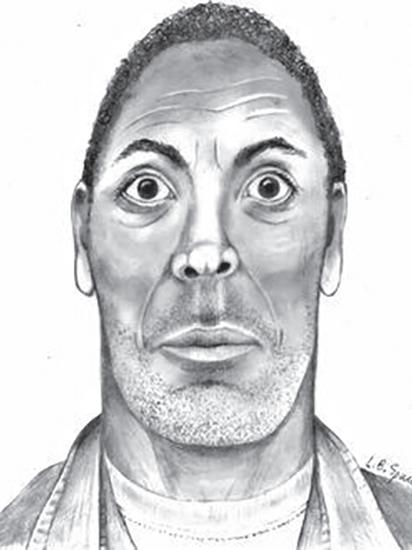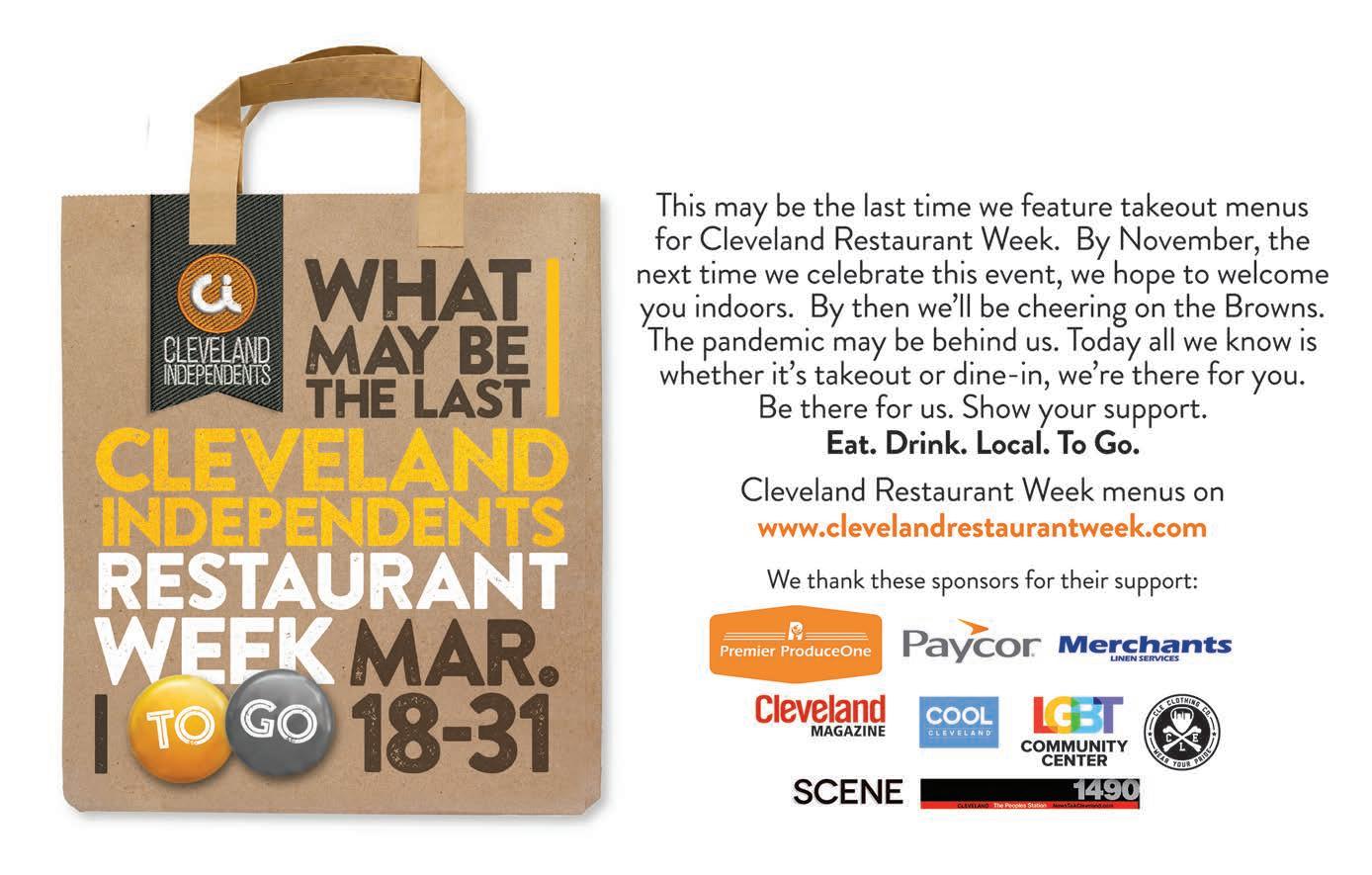
16 minute read
Upfront
NFL ANNOUNCES DETAILS OF LIVE, IN-PERSON DRAFT CEREMONIES IN CLEVELAND

Advertisement
Courtesy the NFL
THE NFL EARLIER THIS WEEK
announced some initial details for the upcoming NFL draft festivities in Cleveland taking place April 29 to May 1. They’ll include limited in-person attendance at an outdoor stage next to FirstEnergy Stadium where Commissioner Roger Goodell will welcome players to their new teams, musical performances at the Rock Hall and fan events inside and around the stadium.
Masks will be mandatory and access to the immediate stage area will be limited to people already vaccinated against Covid and picked by the teams as well as the league and host city.
Specific limits on capacity will be set at a later date by the city of Cleveland and the state of Ohio, and while it won’t allow the crowd sizes of pre-pandemic NFL Drafts it will still be a marquee affair and the largest event in Cleveland since the 2016 RNC.
“We have been characterizing it as a ‘large, live, in-person event,’” said Greater Cleveland Sports Commission CEO David Gilbert told the Sports Business Journal, but, “... not everybody who wants to get in will be able to get in.”
Still, thousands are expected to safely descend on downtown Cleveland with about as much fanfare as one could hope for given the current public health situation. Separate from fan attendees, some 6,000 reporters and staff are expected to work the event.
The lakeside setup near the Great Lakes Science Center will include live outdoor performances at the Rock Hall and the stadium will be open to some number of fans to watch festivities on giant video screens and attempt field goals on the field itself, among other entertainment options.
In addition to representing some return to normalcy as coronavirus numbers dip and jabs in arms continue apace, the NFL hopes to use the event to spread a pro-vax message to help get the world back to normal quicker.
“This draft in particular feels like it represents hope beyond that, because we hope to role model and showcase a bit of what a brighter future continues to look like, in terms of being able to do live, inperson events safely,” NFL Exec VP/ Club Business & League Events Peter O’Reilly told the SBJ.
-Vince Grzegorek
Zack Reed Launches 2021 Mayoral Campaign
As expected, former Cleveland City Councilman and 2017 mayoral contender Zack Reed has launched his campaign for Cleveland Mayor in 2021. Reed last week resigned from his post as a minority affairs coordinator with Secretary of State Frank LaRose. He had long said that stepping down from his state job was a prerequisite for a local run.
“I grew up in Cleveland. I have been in every neighborhood and probably every street,” said Reed, in a campaign announcement sent to the media Monday. “I am running for Mayor to make a difference in the lives of real people throughout this city. An amazing future is within our reach. As Cleveland’s next Mayor, we’re going to strengthen our neighborhoods, create more opportunities and ensure a better life for all residents.”
Reed’s “vision,” as outlined on his new campaign website, centers solutions to poverty, violence and “a lack of opportunity.” He argues that inaction from leadership has resulted in Cleveland’s current
circumstances. “The status quo is never good enough,” he said.
In a conversation at the City Club in the aftermath of summer racial justice demonstrations, Reed rejected the notion of defunding the police, but said that he no longer thought that increasing the number of police officers was the most effective way to combat violence. Bulking up the police force was central to his 2017 campaign.
On his current website, though, Reed says that hiring more officers is one of the first steps in building safer neighborhoods.
“This starts by hiring more officers, increasing police efficiency, response times, training and taking strong measures that hold them accountable,” the vision page reads.
Reed listed a number of additional priorities, including holding the schools accountable, instituting new programs and partnerships at Cuyahoga Community College and overhauling the city’s infrastructure.
A video that Reed shared on Twitter Monday shows the candidate talking to constituents across town, accompanied by a jaunty piano riff. He said he wants to “bring back positive energy” to a city where leadership obstructs, rather than promotes, progress.
“For me it’s never been about some out of touch political agenda,” he says, “It’s about making a difference in the lives of real people.”
Reed was an active campaigner in 2017 and won one of the top two spots in the primary election. He ultimately lost, in decisive fashion, to incumbent Frank Jackson. Reed is a lifelong resident of Cleveland’s Mt. Pleasant neighborhood on the southeast side, an area he represented on city council from 2001-2017. He’ll be competing for votes there with, among others, young executive Justin Bibb, one of the only serious candidates who has declared. -Sam Allard
City of Cleveland’s Johnson & Johnson Vaccine All Went to Metro for Homeless Population
The City of Cleveland has received far fewer doses of the single-dose Johnson & Johnson coronavirus vaccine from the state of Ohio than they have of the two-dose Moderna and Pfizer vaccines, the city’s chief of youth, Tracy Martin-Thompson, (who oversees the health department), told city council last week.
To date, the city has received only 300 of the Johnson & Johnson vaccines, and all of them were delivered to the MetroHealth hospital system to be administered to the city’s homeless population, MartinThompson said.
MetroHealth confirmed to Scene that this was the case. The public hospital system had last week already administered 500 first doses of the Moderna vaccine to both members of the homeless community and staff workers who regularly interact with them. The City of Cleveland provided those doses to the Cuyahoga County Board of Health, and were administered by Metro.
Metro then received the Johnson & Johnson doses Friday. They planned to administer them last week and this week at a number of shelters and service providers for people experiencing homelessness, including Frontline, Lutheran Metropolitan Ministries, the West Side Catholic Center, St. Herman’s House of Hospitality, Journey DVCAC, the Metanoia Project, and others.
“It is a privilege to serve this community, which is among the most vulnerable, and is in keeping with MetroHealth’s mission,” a MetroHealth spokesman wrote Scene in an email. -Sam Allard
Kate Warren to Run for City Council in Kevin Kelley’s Ward 13
Kate Warren, a 31-year-old research fellow at the Center for Community Solutions, announced this weekend that she will run for Cleveland City Council in Ward 13.
Warren, who grew up primarily in Lorain County and completed undergraduate and graduate degrees at Cleveland State University, told Scene that she began to seriously consider a city council bid this summer. She is seeking the office, she said, out of a love for her community and a desire to help solve the thorniest structural issues facing Cleveland and its residents, especially poverty.
Having worked directly with those experiencing homelessness at the City Mission prior to joining the Center for Community Solutions, Warren feels that she has a unique skill set to offer constituents in Ward 13, which includes Old Brooklyn and a tiny sliver of the Stockyards neighborhood.
“I have direct service experience, and I also have big picture experience with research and public policy work,” she said. “I think I’ll be able to provide quality city services — residents expect their councilperson to address the basic things they need from city government — while also thinking about policy work to improve living conditions.”
Warren worked with volunteers in Ward 13 during the 2020 presidential election and is currently assembling a campaign team. Her social media announcements over the weekend were met with enthusiastic support.
She plans to formally launch her campaign on April 7, at which time she’ll have more to say about her platform and ward-specific priorities. She told Scene, though, that residents could expect her to work hard on citywide issues like poverty and health.
As for her campaign, she told Scene she firmly believes in the power of teamwork not only in winning elections, but in engaging residents.
“I believe competitive races across the city are good because they engage residents and get people thinking about how they want city government to serve them,” she said. “There’s a lot of really good energy around this municipal election. There are fresh faces and people who are really qualified and hard-working who want to make a difference. I thought, maybe I should throw my hat in the ring in Ward 13.”
Warren has lived in the Old Brooklyn neighborhood for more than a decade. The Ward is currently represented by Council President Kevin Kelley, who has assembled a massive campaign war chest and is widely assumed to be running for Mayor, though he has not yet officially declared his candidacy. He has said that he would not make up his mind until he completes a neighborhood listening tour.
-Sam Allard
Lakewood Passes Pay to Stay Legislation, a Win for Tenants’ Rights
The City of Lakewood passed legislation last week that will allow tenants to avoid eviction if they pay their full rent and late fees prior to their eviction hearing.
Currently, Ohio is one of only five states in the country where a landlord may file for eviction immediately upon nonpayment of rent. Lakewood’s “Pay to Stay” legislation gives tenants a legally required grace period.
Lakewood is one of several Cleveland suburbs now considering the no-brainer legislation, thanks in large part to the advocacy of groups like the Northeast Ohio Coalition for the Homeless, (NEOCH). The goal of the advocacy groups, ultimately, is to get the City of Cleveland on board and then pass Pay to Stay Countywide.
In Lakewood, the legislation made too much sense not to pursue, said Council President Dan O’Malley.
“It’s common sense that if a tenant pays their rent in full, they should be able to stay in their home,” he told Scene last month, after he’d introduced the ordinance. “Maintaining stability in housing should be a higher priority for governments as we continue the economic and health impacts of COVID-19. The goal of this legislation is to provide that stability without impacting the economic well-being of landlords.”
O’Malley noted that other cities in Ohio had recently passed Pay to Stay ordinances as well. Both Toledo and Yellow Springs passed versions of the tenant protection in 2020.
As initially proposed, the legislation would have sunset at the end of the pandemic state of emergency, but at this week’s hearing, where residents spoke in favor of making the ordinance permanent, councilmen Tristan Rader and John Litten pushed for it to be extended until the end of 2022, with a mandatory review before the legislation’s sunset.
“I am pleased we were able to pass this important law that will allow renters to stay in their homes,” Tristan Rader told Scene. “If someone is able to catch up on back due rent, they have the right to keep their housing. I hope we can make this law permanent in the near future, and I’m very happy we could protect renters today.”
Molly Martin, NEOCH’s Director of Strategic Initiatives, told Scene that among other things, Pay to Stay legislation like Lakewood’s would add substance to symbolic declarations of racism as a public health crisis in the region by protecting black renters.
“Over 85% of the people in our shelter system are BIPOC and the majority of evicted households include single black women with children,” she said. “The spotlight is on Cleveland right now. We are the poorest big city in the country. There’s a mayoral and city council elections happening this year, Marcia Fudge was nominated for HUD Secretary, and the 11th congressional district seat is up for grabs. While Pay to Stay is just one example, focusing on stable housing rights is a real way to show people in our community that they have a reason to show up to the polls.”
-Sam Allard
DNA Will be Tested in Grisly Cleveland Cold Case from 1969
On the morning of August 29, 1969, Frank Forney dropped off his 15-year-old stepson, Danny Little, at a property he owned on E. 82nd St. to clean up the lot and burn the trash. This was near the tracks, not far from an old factory and there was junk everywhere. The boy spotted a barrel abandoned in the field next door and figured he could burn the trash inside it. So Little rolled it over and as he went, he noticed a foul smell. When he unsealed the top, the boy discovered a body inside.
The victim was a young Black man who had been shot nine times. His legs had been sawed off before he was placed into the 55-gallon-drum and covered in some kind of caustic fluid. Then-Cuyahoga County Coroner Dr. Charles Hirsch also found the victim had suffered significant blunt force trauma to his head.
Cleveland police attempted to identify the man, to no avail, even though they had some good clues. He was found wearing a Waltham wristwatch and a gray metal ring with a blue stone on his 4th finger. He also sported a tattoo – the name, Sally — on the inside of his left forearm. Based on the narrow shape of the man’s skull, it is believed he may have had Crouzon Syndrome, which would have made his eyes appear to be bulging, giving him a very distinct look.
Detectives wondered if his murder was connected to the Black Panther Party.
It’s not a big leap to believe that the Doe in the barrel might have been connected to the Panthers in some way. In the 1960s, the east side of Cleveland was a powder keg of racial tension. There were the Hough riots, in 1966. And then, just a year before the unknown man’s murder, there was a four-hour long shootout in Glenville, between police and a group called the Black Nationalists of New Libya, which led to the deaths of three policemen and three suspects. After decades of Jim Crow laws, black nationalism was on the rise. Some organizations in Cleveland were peaceful. Others, not so much.
The FBI had confidential informants inside the Cleveland chapter of the Black Panther party who fed them a steady stream of information about members as well as the logistics behind a distribution network that circulated propaganda newspapers from of their headquarters in Queens. Was the dead guy a member of the Panthers or the Nationalists of New Libya or some more extreme group? His murder – shot nine times, beaten, sawed in half – certainly has all the hallmarks of an organized hit.
But to this day, nobody knows this man’s name. Nobody has found Sally, who he memorialized on his arm. Fifty-two years have gone by.
This man’s death is an untold part of Cleveland’s history and new science may be our best shot at uncovering it. The Porchlight Project, a local nonprofit dedicated to solving Ohio cold cases, has agreed to completely fund the DNA tests and genetic genealogy that could lead to finally identifying this victim.
The Porchlight Project recently assisted the Cuyahoga Falls Police Department by providing the funds to test DNA in the 1987 unsolved murder of Barbara Blatnik, which led to the arrest of James Zastawnik for Blatnik’s murder last May.
“At the Cuyahoga County Medical Examiner’s Office, we never give up hope that we may provide closure to families and bring criminals to justice even years after a death has occurred,” says Cuyahoga County Medical Examiner, Dr. Thomas Gilson. “We are very eager to partner with The Porchlight Project on this case and hope that our effort will be successful. It would also be uniquely satisfying to me to see this case through to completion as the late Dr. Hirsch, the original coroner, was my teacher in forensic pathology.”
Last week, the Medical Examiner’s office shipped a piece of the victim’s bone to Othram, Inc., a one-stop-shop for DNA testing and genetic genealogy in Texas.

Cuyahoga County Medical Examiner

Othram’s scientists are experts at recovery, enrichment, and analysis of human DNA, even when the sample is small or degraded.
“Othram’s DNA profiles have been used to identify victims from some of the oldest forensic evidence and we look forward to helping advance this case,” says David Mittelman, Othram CEO.
Should the fifty-year-old bone prove to be viable, the lab at Othram will then identify the specific markers in the man’s DNA profile that are used to match with relatives who have uploaded their profiles into public databases like GEDMatch and FamilyTree. With a little luck, a match in a database will lead genealogists to the family of the deceased and, from there, to his identity. - James Renner
James Renner is a former writer for Cleveland Scene and the founder of The Porchlight Project. To learn more, please visit porchlightonline.org.
DIGIT WIDGET
15
Cleveland State University seeding in the NCAA Men’s Basketball tournament. The Vikings fell to the 2-seed Houston Cougars last Friday night in first-round action.
$40,000
Bonus for CSU men’s basketball coach Dennis Gates for winning Horizon League Coach of the Year ($10k), having the best record in the Horizon League ($10k), winning the Horizon League Championship ($15k), and having a conference record of better than .500 ($5k). Gates’ base salary for the 2020-2021 season was $285,000.

$0.10
Cost of a beer at Market Garden Brewery to the first 2021 people who bring their vaccination card to the brewpub on W. 25th Street.
$0.00
Cost of a Krispy Kreme donut for anyone who’s been vaccinated. (One per day for the rest of 2021.)
Fox 8 Report: Covid Vaccine Doesn’t Prevent You From Dying From Other Things
In ‘big if true’ news: Fox 8 last weekend reported that some people who have gotten the Covid vaccine have somehow still died of other stuff.
As it turns out, the Covid vaccine does not grant immortality, nor does it prevent one from dying of cancer, or a heart attack, or renal failure, or any other of the many things that cause human beings to expire.
The basis for the breaking news story were 63 Ohio deaths reported through the Vaccine Adverse Event Reporting System, which allows literally anyone to make a report with any or no supporting evidence, after some two million Ohioans have received one of the Covid vaccines. Demographically, those recipients skew older, as the state’s first stages of the rollout included residents over the age of 60.
The motivation for the story, one could surmise, was optimal SEO on a story about vaccines and deaths, even though the CDC has reported that, “A review of available clinical information including death certificates, autopsy, and medical records revealed no evidence that vaccination contributed to patient deaths” after more than 100 million vaccine doses have been given across the country.
While Fox 8 possibly preps a followup story detailing how some Ohioans that have recently died have, at some point in their lives, enjoyed a breakfast of an omelet and a glass of orange juice, health officials have been waging a critical battle to win the confidence of the general public, spreading the message far and wide that science has proven the vaccine to be safe.
With a claim to the largest audience in Northeast Ohio among all TV stations, and by a wide margin, one would hope that Fox 8 would use its outsized megaphone to amplify that message responsibly. Blasting out that “dozens have died among those vaccinated,” despite the meat and bones of the story itself, is simply conspiratorial chum for the internet, and saying that the deaths are “not linked” unnecessarily gives credence to the idea that there was a question whether they were in the first place.
-Vince Grzegorek
scene@clevescene.com @clevelandscene




